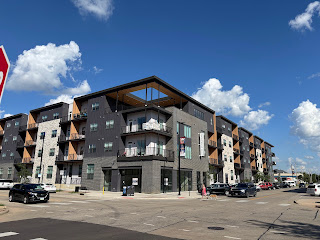
The challenges faced by religious institutions in today's West are highlighted even when celebrating the year's best artistic and architectural achievements. Editor Michael J. Crosbie noted increasing numbers of nominations in recent years discussed their projects at least in part in terms of the "need [to] forge connections between the faith community and the context" (Crosbie 2018).
Here on Holy Mountain, we're all about the context i.e. the work of the religious body in the world, and how the group acts out its relationship to the world. Often that starts with the building. So while something like this is eye-catching and would probably be even more impressive if I knew all of the design and engineering that had to go into it...
 |
| Snyder Chapel, Lynn University, Boca Raton FL (Source: faithandform) |
Other trends: a lot of renovation-related nominations, but only two entries in the adaptive re-use/re-purpose categories. Also, "The absence of megachurches submitted might indicate a decline in their construction." I am not sorry if this is true. Marc Auge (Non-Places: An Introduction to Supermodernity [Verso, 2nd ed, 2008]) considers all houses of worship to be "anthropological places" because the people who gather there have specific identity, rituals, stories and such. The standardizing of the megachurch form, however, verges on making it a non-place, with the individual worshiper in the role of spectator-consumer, sort of like at a religious mall.
Churches, synagogues and other houses of worship surely have a lot on their plates:
- They provide both welcome to the stranger and a haven for their members, which must be hard to balance in practice;
- The best of them maintain a presence in their neighborhood, while accommodating the vast majority of their attendees who arrive by single-family auto; and
- Their worship spaces are at once functional (this is where the act of worshiping gets done) and political (their design speaks volumes to group dynamics like community and hierarchy).
With that said, and with every disclaimer you can possibly imagine, three award winners struck me as particular examples of successful religious urbanism.
1. All Saints Episcopal Church, Chicago, Illinois (Religious Architecture--Restoration).
 |
| (Source: faithandform) |
 |
| (Source: Google street view screen capture) |
 |
| (Source: faithandform) |
3. Our Lady of Good Counsel Church, Deepdene, Victoria, Australia (Religious Architecture--Renovation).
 |
| (Source: faithandform) |
 |
| (Source: Google street view screen capture) |
Religious organizations have a lot to offer America in the 21st century--a sense of the sacred and permanent, experience acting in common, a place to be quiet--and design has a lot to contribute to that. Design needs to emphasize neighborliness, though, without which the house of worship is merely an isolated island. A structure like this clearly received a lot of expert attention and boasts some striking design features.
 |
| Christ Cathedral Arboretum and Tower of Hope, Garden Grove CA (Source: faithandform) |
Primary Source: Michael J. Crosbie (ed), "2018 International Awards Program for Religious Art and Architecture," Faith and Form 51:4 (2018)
Last Year's Model: "The Future of Religious Spaces (IV)," 1 January 2018
The Fall 2018 issue of The Wheel includes a review of an intriguing book analyzing worship spaces from an Eastern Orthodox perspective: Nicholas Denysenko, Theology and Form: Contemporary Orthodox Architecture in America (Notre Dame Press, 2017). Hat tip to F. John Herbert for this item.
The Fall 2018 issue of The Wheel includes a review of an intriguing book analyzing worship spaces from an Eastern Orthodox perspective: Nicholas Denysenko, Theology and Form: Contemporary Orthodox Architecture in America (Notre Dame Press, 2017). Hat tip to F. John Herbert for this item.















